|

Height and Weight: According to the AKC breed standard, a Doberman bitch's shoulder height is between 24 to 26 inches, and weight is between 65 to 75 pounds, while the male stands between 26 to 28 inches at the shoulder and weighs between 75 to 85 pounds. The Fédération Cynologique Internationale standard is slightly different and is followed by most countries. A male Doberman should stand 26.5 to 28 inches (68 to 72 cm) and weigh between 89 to 100 pounds (40 to 45 kg). A bitch should stand 24.5 inches to 27 inches (63 to 68 cm) and weigh between 71 to 78 pounds (32 to 35 kg).
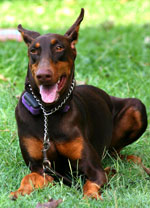 Body Type : Dobermans typically have a deep, broad chest, and a powerful, muscular body of medium size. However, in recent years some breeders have primarily bred, shown, and sold a slimmer or more slender-looking Doberman. This has become a popular body type among many owners, especially those who want to show their Dobes competitively. The traditional body type is still more desirable to many casual owners and to those who want the dog for protection. Body Type : Dobermans typically have a deep, broad chest, and a powerful, muscular body of medium size. However, in recent years some breeders have primarily bred, shown, and sold a slimmer or more slender-looking Doberman. This has become a popular body type among many owners, especially those who want to show their Dobes competitively. The traditional body type is still more desirable to many casual owners and to those who want the dog for protection.
Furthermore, despite the "ideal" standards, it is impossible to have complete control over the size and weight of dogs. Generally speaking, show animals must fall within the ideal range of both size and weight (for that country's breed standard), but it is not unusual to find male Dobies weighing over 100 pounds or females that are also larger than called for by the breed standards. Larger sizes might lead to additional health problems, although those who are looking for a Doberman to provide personal protection or for use in police agencies or the military generally seek out the larger examples and some breeders create specific breeding pairs in the hope of getting a litter of large dogs.
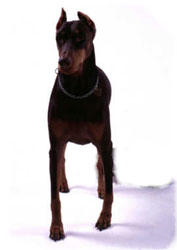 Color: Most people picture a Doberman's Color: Most people picture a Doberman's
color as the typical black with rust markings. However, the existence of two different
color genes in the Doberman provides four different phenotypes in Doberman color. The traditional color, produced when one or both genes have the dominant allele, is commonly referred
to as black or black and rust (also called
black and tan), while the most common
variation, due to both genes having the
recessive allele, produces what is called a
red or red and rust Doberman in America and a "brown" Doberman in the rest of the world,
which is primarily deep reddish-brown with
rust markings.
The other gene having the recessive allele, while the first one retains the dominant, produces the blue (gray) Doberman, whereas the least likely combination of both color genes having recessive alleles produces fawn, which is a light tan color, often called Isabella.
A White Doberman? In the 1970s a "white" Doberman was born, and she was subsequently bred to her son who was also bred to his litter sisters. This tight inbreeding went on for some time so certain breeders could "fix" the mutation, which has been widely marketed. Dobermans of this color possess a genetic mutation, which prevents its pigment proteins from being manufactured, regardless of the genotypes of either of the two color genes; that is, it is an albino.
Though many potential Doberman owners find the color beautiful, albino Dobermans, like albinos of other species, face increased risk of cancer and other diseases and should avoid sun exposure as much as possible. The popularity of the "white" Dobermann has died down dramatically as the risks have become known, with many people even calling for an end to the breeding and marketing of the white Doberman, because they perceive it as cruelty to the animal. Some countries have made the purposeful breeding of the white Doberman illegal, but breeders who care and take note of the ancestors can avoid breeding albinos as they are all descended from the original bitch.
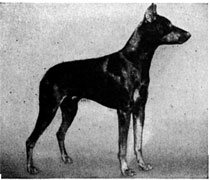 Tail Docking: Although the Doberman is most commonly seen with its traditional short tail, it is actually born with a tail that is longer than many breeds. Typically, a Doberman Pinscher undergoes docking, a procedure in which the majority of its tail is cut off or removed in other ways within days after its birth. The rationale being that it completes the sleek "look" that the dog is supposed to have, since it was the way Louis Dobermann had originally envisioned the dog. Tail Docking: Although the Doberman is most commonly seen with its traditional short tail, it is actually born with a tail that is longer than many breeds. Typically, a Doberman Pinscher undergoes docking, a procedure in which the majority of its tail is cut off or removed in other ways within days after its birth. The rationale being that it completes the sleek "look" that the dog is supposed to have, since it was the way Louis Dobermann had originally envisioned the dog.
Aside from these reasons that many view as inhumane, one practical reason for docking the tail is that it removes what would be a convenient "handle" for a criminal or attacker to grab when the Doberman is performing its guard or police work. Another reason is that dogs with the thin, whip-like tail of the Doberman have a very common occurrence of "broken tail". Broken tail may range from the actual tail bones being broken to the more common skin injuries that are very difficult to heal because of the difficulty of bandaging or protecting the tail. Broken tail is often a self inflicted injury caused by the Doberman enthusiastically wagging its long tail, regardless of the objects it is hitting with it.
Regardless of people's beliefs on this matter, few potential owners have a choice on the length of their Doberman's tail; docking must be done soon after the dog's birth, which means that the breeder nearly always makes the decision, before their dogs are even put on the market.
Ear Cropping: This is not true, however, of Doberman ear cropping, which should be done between 7 and 9 weeks. It is something that should be taken care of while still in the breeder's care, before the puppy goes home with its new owners. Cropping done after 12 weeks has a high rate of failure in getting the ears to stand. Some Doberman owners prefer not to have their pet's ears cropped because they believe the procedure may be painful for the animal. The process involves trimming off part of the animal's ears and then propping them up with posts and tape bandages, which allows the cartilage to develop into an upright position as the puppy grows. The puppy will still have the ability to lay the ears back or down. The process of posting the ears generally takes about a month, but longer show crops can take several months.
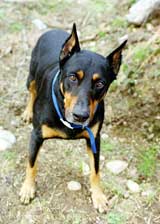 While there have been no studies that involved looking at cropped vs non-cropped Dobermans, it is believed that cropping dramatically reduces the occurrence of ear infections and hematomas (blood blisters caused by damage to the ear tips, commonly from hard shaking of the head). While there have been no studies that involved looking at cropped vs non-cropped Dobermans, it is believed that cropping dramatically reduces the occurrence of ear infections and hematomas (blood blisters caused by damage to the ear tips, commonly from hard shaking of the head).
Although the acts of cropping and docking seem inhumane to some, the traditional Doberman has always been the one that has had both procedures. In some countries, docking and cropping are now illegal, but in some breed shows Dobermans are allowed to compete only if they have the traditional look.

Doberman Temperament: The Doberman is often used as a protection dog, due to its intelligence, loyalty, and ability to physically challenge human aggressors. Dobermans are even now, and once more extensively, used in police work and in the military and are top fighting dogs if trained properly. In these roles, they inspire fear. They are often stereotyped in such roles in movies (where they are trained to exhibit seemingly "aggressive" behavior), and consequently many people are afraid of the breed. A related problem is the misunderstanding of their legitimate roles; because guard dogs are trained to neutralize unwelcome intruders, many people mistakenly believe that Dobermans are vicious. Further stereotyping occurs in Resident Evil where the vicious Cerberus dogs, which attack the characters at the start of the game and attack the player throughout the game, are Dobermans infected with the T-Virus.
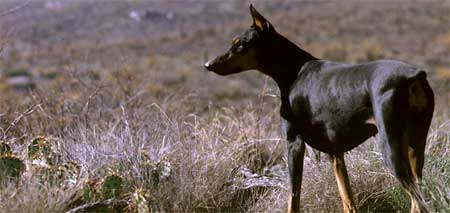
However, Dobermans are, in general, a loyal, loving, and intelligent breed. Although there is variation in temperament, a typical pet Doberman attacks only when it feels that it, its property, or its family are in danger. According to a study done by the U. S. Centers for Disease Control, the Doberman is involved in human dog bite-related incidents less frequently than many other dog breeds. Those familiar with the breed consider well-bred and properly socialized Dobermans to be excellent pets and companions, suitable for families with other dog breeds, excellent with young children, and even cats.
Health: An average, healthy Doberman is expected to live close to 12 years, with a majority of Dobermans dying between age 11 and 13. Common health problems are dilated cardiomyopathy, von Willebrands disease (a bleeding disorder that can be tested for genetically), hypothyroidism, cancer, and in the dilute colors (blues and fawns), alopecia (see follicular dysplasia).

Doberman History: Dobermans were first bred in Germany around 1890 by Karl Friedrich Louis Dobermann. He was a tax collector who needed a protection dog to guard him, so he set out to breed a new type of dog that, in his opinion, would be the perfect combination of strength, loyalty, 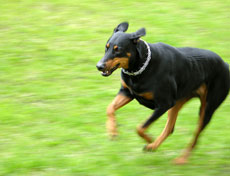 intelligence, and ferocity. He also worked with dogs as a second job, giving him access to dogs for breeding. Later, Otto Goeller and Philip Gruening continued to develop the breed. intelligence, and ferocity. He also worked with dogs as a second job, giving him access to dogs for breeding. Later, Otto Goeller and Philip Gruening continued to develop the breed.
The breed is believed to have been created from several different breeds of dogs that had the characteristics that Doberman was looking for, including the Pinscher, the Rottweiler, the Thuringian Shepherd Dog, the black Greyhound, the Great Dane, the Weimaraner, the German Shorthaired Pointer, and the German Shepherd Dog. The exact ratios of mixing, and even the exact breeds that were used, remains uncertain to this day, although many experts believe that the Doberman is a combination of at least four of these breeds. The single exception is the documented cross with the Greyhound. It is also widely believed that the German Shepherd gene pool was the single largest contributor to the Doberman breed.
Famous Dobermans
* Bingo von Ellendonk - first Doberman to score 300 points (perfect score) in Schutzhund
* Graf Belling v. Grönland - first registered Doberman
Dobermans in fiction
* Blitz from Road Rovers
* Roscoe and DeSoto from Oliver & Company
* Rothko from "My Wrongs 8245 - 8249 and 117"
* Luka from Garfield: The Movie
* Zeus and Apollo from Magnum P.I.
* Cerberus (zombie dogs or dobermann zombies) from Resident Evil
* Sniper from Ginga: Nagareboshi Gin
All text is available under the terms
of the GNU Free Documentation License
|
